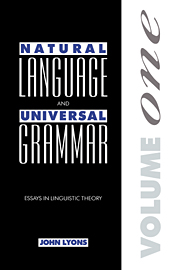Book contents
- Frontmatter
- Contents
- Preface
- Typographical conventions
- 1 Language, speech and writing
- 2 In defence of (so-called) autonomous linguistics
- 3 Linguistic theory and theoretical linguistics
- 4 Natural, non-natural and unnatural languages: English, Urdu and other abstractions
- 5 The origin of language, speech and languages
- 6 Phonemic and non-phonemic phonology: some typological reflections
- 7 Towards a ‘notional’ theory of the ‘parts of speech’
- 8 Deixis as the source of reference
- 9 Deixis and anaphora
- Appendix: The scientific study of language. Inaugural Lecture, Edinburgh, 1965
- Notes
- References
- Subject index
- Names index
7 - Towards a ‘notional’ theory of the ‘parts of speech’
Published online by Cambridge University Press: 05 June 2012
- Frontmatter
- Contents
- Preface
- Typographical conventions
- 1 Language, speech and writing
- 2 In defence of (so-called) autonomous linguistics
- 3 Linguistic theory and theoretical linguistics
- 4 Natural, non-natural and unnatural languages: English, Urdu and other abstractions
- 5 The origin of language, speech and languages
- 6 Phonemic and non-phonemic phonology: some typological reflections
- 7 Towards a ‘notional’ theory of the ‘parts of speech’
- 8 Deixis as the source of reference
- 9 Deixis and anaphora
- Appendix: The scientific study of language. Inaugural Lecture, Edinburgh, 1965
- Notes
- References
- Subject index
- Names index
Summary
The purpose of this article is to initiate a discussion of the ‘parts of speech’ within the framework of generative grammar. The present writer has long been of the opinion that the traditional, ‘notional’ theory of the ‘parts of speech’ merits a rather more sympathetic consideration than it has received from most linguists in recent years and feels, with Chomsky (1965: 118), that ‘although modern work has, indeed, shown a great diversity in the surface structures of languages …, the deep structures for which universality is claimed may be quite distinct from the surface structures of sentences as they actually appear’, and that ‘the findings of modern linguistics are thus not inconsistent with the hypotheses of universal grammarians’. The distinction that is drawn by Chomsky between ‘deep’ and ‘surface’ structure was implicit in traditional grammatical theory and has been reasserted by a number of modern scholars (cf. also Hockett, 1958; Lamb, 1964b; Halliday, 1966c: 57; etc.). This distinction will be taken for granted throughout the paper. It will also be taken for granted that any satisfactory general theory of syntactic structure must be ‘transformational’ (in the sense of Chomsky, 1957; etc.). Towards the end of the paper, however, it will be suggested, on the basis of the arguments presented below, that current theories of transformational grammar stand in need of radical revision; in particular, that the rules of the base component should operate upon two different kinds of elements, ‘constituents’ (bracketed categories) and ‘features’ (for the most part, the traditional ‘secondary grammatical categories’ – tense, mood, aspect, etc.).
- Type
- Chapter
- Information
- Natural Language and Universal GrammarEssays in Linguistic Theory, pp. 110 - 145Publisher: Cambridge University PressPrint publication year: 1991



